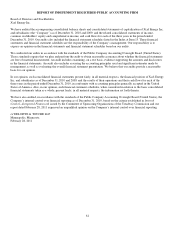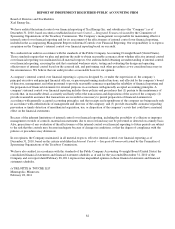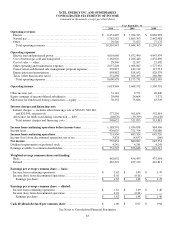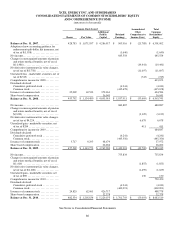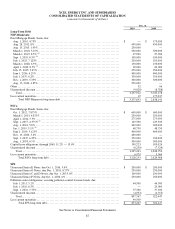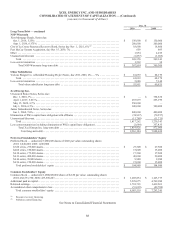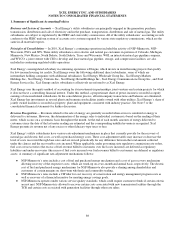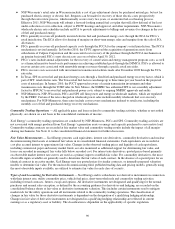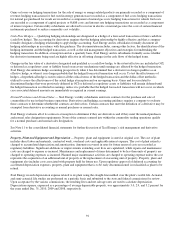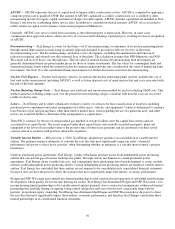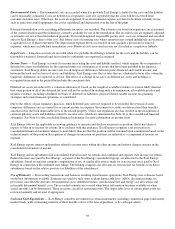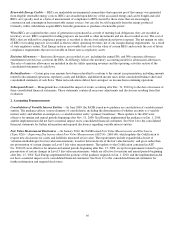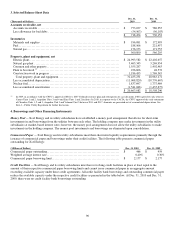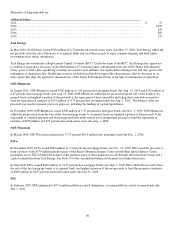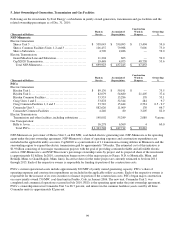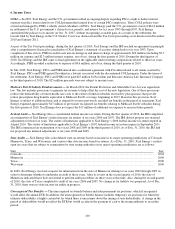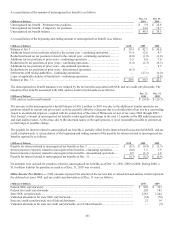Xcel Energy 2010 Annual Report Download - page 101
Download and view the complete annual report
Please find page 101 of the 2010 Xcel Energy annual report below. You can navigate through the pages in the report by either clicking on the pages listed below, or by using the keyword search tool below to find specific information within the annual report.91
Gains or losses on hedging transactions for the sale of energy or energy-related products are primarily recorded as a component of
revenue; hedging transactions for fuel used in energy generation are recorded as a component of fuel costs; hedging transactions
for natural gas purchased for resale are recorded as a component of natural gas costs; hedging transactions for vehicle fuel costs
are recorded as a component of capital projects or O&M costs; and interest rate hedging transactions are recorded as a component
of interest expense. Certain utility subsidiaries are allowed to recover in electric or natural gas rates the costs of certain financial
instruments purchased to reduce commodity cost volatility.
Cash Flow Hedges — Qualifying hedging relationships are designated as a hedge of a forecasted transaction or future cash flow
(cash flow hedge). The accounting for derivatives requires that the hedging relationship be highly effective and that a company
formally designate a hedging relationship to apply hedge accounting. Xcel Energy and its subsidiaries formally document all
hedging relationships in accordance with this guidance. The documentation includes, among other factors, the identification of the
hedging instrument and the hedged transaction, as well as the risk management objectives and strategies for undertaking the
hedging transaction. In addition, at inception and on a quarterly basis, Xcel Energy and its subsidiaries formally assess whether
the derivative instruments being used are highly effective in offsetting changes in the cash flows of the hedged items.
Changes in the fair value of a derivative designated and qualified as a cash flow hedge, to the extent effective are included in OCI,
or deferred as a regulatory asset or liability based on recovery mechanisms until earnings are affected by the hedged transaction.
Xcel Energy discontinues hedge accounting prospectively when it has determined that a derivative no longer qualifies as an
effective hedge, or when it is no longer probable that the hedged forecasted transaction will occur. To test the effectiveness of
hedges, a hypothetical hedge is used to mirror all the critical terms of the hedged transaction and the dollar-offset method is
utilized to assess the effectiveness of the actual hedge at inception and on an ongoing basis. Gains and losses related to
discontinued hedges that were previously deferred in OCI or deferred as regulatory assets or liabilities will remain deferred until
the hedged transaction is reflected in earnings, unless it is probable that the hedged forecasted transaction will not occur, in which
case associated deferred amounts are immediately recognized in current earnings.
Normal Purchases and Normal Sales — Xcel Energy’s utility subsidiaries enter into contracts for the purchase and sale of
commodities for use in their business operations. Derivatives and hedging accounting guidance requires a company to evaluate
these contracts to determine whether the contracts are derivatives. Certain contracts that meet the definition of a derivative may be
exempted from derivative accounting as normal purchases or normal sales.
Xcel Energy evaluates all of its contracts at inception to determine if they are derivatives and if they meet the normal purchases
and normal sales designation requirements. None of the contracts entered into within the commodity trading operations qualify
for a normal purchases and normal sales designation.
See Note 11 to the consolidated financial statements for further discussion of Xcel Energy’s risk management and derivative
activities.
Property, Plant and Equipment and Depreciation — Property, plant and equipment is stated at original cost. The cost of plant
includes direct labor and materials, contracted work, overhead costs and applicable interest expense. The cost of plant retired is
charged to accumulated depreciation and amortization. Amounts recovered in rates for future removal costs are recorded as
regulatory liabilities. Significant additions or improvements extending asset lives are capitalized, while repairs and maintenance
costs are charged to expense as incurred. Maintenance and replacement of items determined to be less than units of property are
charged to operating expenses as incurred. Planned major maintenance activities are charged to operating expense unless the cost
represents the acquisition of an additional unit of property or the replacement of an existing unit of property. Property, plant and
equipment also includes costs associated with property held for future use. Upon regulatory approval of deferred accounting for
accelerated depreciation expenses, property, plant and equipment that is to be early decommissioned is reclassified as plant to be
retired.
Xcel Energy records depreciation expense related to its plant using the straight-line method over the plant’s useful life. Actuarial
and semi-actuarial life studies are performed on a periodic basis and submitted to the state and federal commissions for review.
Upon acceptance by the various commissions, the resulting lives and net salvage rates are used to calculate depreciation.
Depreciation expense, expressed as a percentage of average depreciable property, was approximately 3.0, 2.9, and 3.2 percent for
the years ended Dec. 31, 2010, 2009 and 2008, respectively.


